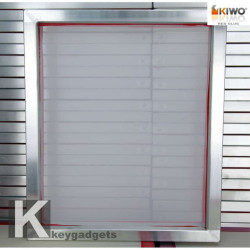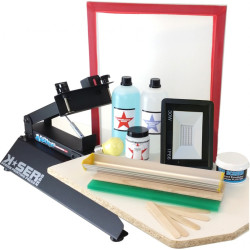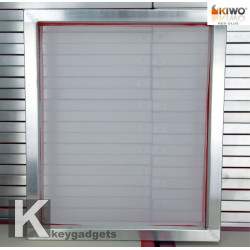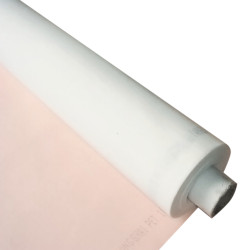Screen Printing Screens and Frames – The Ultimate Guide to High-Quality Prints
Choosing the right screen printing screens and frames is essential for achieving professional, high-quality prints. Whether you're a beginner or an experienced screen printer, having the right screen print setup ensures precision, durability, and vibrant results. From aluminum screens to pre-coated screens, selecting the correct mesh, frame, and screen printing supplies can make a huge difference in your print quality.
In this guide, we’ll explore everything you need to know about screens for screen printing, including how to choose the right printing frame, the benefits of pre-burned screens, and tips on screen printing supplies and equipment. If you’re looking to improve your printing process or invest in premium aluminum screens, this article is for you.
Table of Contents
- What Are Screen Printing Screens and Frames?
- Why Are Screen Printing Frames Important for Precision?
- How to Choose the Right Mesh for Your Screen Prints
- Aluminum vs. Wood Frames – Which One Should You Use?
- Pre-Burned Screens vs. Pre-Coated Screens – What’s the Difference?
- What Mesh Count Should You Use for Different Inks and Prints?
- How to Properly Prepare a Screen for Printing
- Essential Screen Printing Supplies and Equipment for High-Quality Prints
- Top Screen Printing Kits for Beginners and Professionals
- Where to Buy High-Quality Screen Printing Screens and Frames
What Are Screen Printing Screens and Frames?
A screen printing screen consists of a mesh stretched over a frame, which acts as a stencil for transferring ink onto a fabric or other material. These screens come in various mesh counts, which determine the level of detail and ink flow in a print. The printing frame provides stability and ensures the screen stays taut during the printing process.
The combination of a high-quality screen and a durable frame allows screen printers to create vibrant, long-lasting prints. Whether you're printing with plastisol or water-based ink, having the right screen printing screens is crucial for achieving exceptional results.
Why Are Screen Printing Frames Important for Precision?
A screen printing frame holds the screen in place, ensuring that the stencil remains steady during the print process. A well-built frame provides:
- Precision – Keeps the screen stable for sharp print details.
- Durability – Withstands repeated use and screen print pressure.
- Efficiency – Allows for quick and easy screen setup.
Frames come in different materials, such as wood and aluminum, each offering unique benefits for screen printers.
How to Choose the Right Mesh for Your Screen Prints
The mesh count of a screen determines how much ink passes through and the level of detail in your print. Lower mesh counts (110 and below) allow for more ink flow, making them ideal for bold graphics and thick inks like plastisol. Higher mesh counts (200 and above) are perfect for fine detail work and water-based inks.
When selecting a screen, consider:
- 110 mesh – Ideal for general screen printing with thick ink.
- 156 mesh – Balanced option for medium detail prints.
- 230 mesh – Best for fine detail and halftones.
Aluminum vs. Wood Frames – Which One Should You Use?
When selecting a screen printing frame, you’ll find two main options:
Wood Frames
- Affordable and easy to use.
- Can warp over time due to moisture exposure.
- Best for small-scale screen printers or beginners.
Aluminum Frames
- Lightweight, durable, and resistant to warping.
- Ideal for long-term use and high-volume screen print shops.
- Premium aluminum frames provide excellent tension and stability.
For professional screen printing, aluminum screens are the best option due to their durability and reliable performance.
Pre-Burned Screens vs. Pre-Coated Screens – What’s the Difference?
Pre-burned screens and pre-coated screens are designed to save time and simplify the screen printing process.
- Pre-burned screens come with a ready-to-use emulsion stencil, eliminating the need for screen preparation.
- Pre-coated screens have a uniform layer of emulsion, allowing screen printers to expose their own designs.
Both options are perfect for screen printing shops that want a faster, more efficient setup.
What Mesh Count Should You Use for Different Inks and Prints?
Matching the right mesh count with your ink type ensures optimal print results.
- 110 mesh – Great for bold designs and plastisol inks.
- 156 mesh – A versatile option for medium detail and most screen printing supplies.
- 230+ mesh – Best for high-quality prints, detailed graphic work, and water-based inks.
Selecting the correct mesh helps maintain precision and prevents excess ink from flooding your print.
How to Properly Prepare a Screen for Printing
To achieve a flawless screen print, follow these steps:
- Degrease the screen – Remove dust and oils before coating with emulsion.
- Apply emulsion evenly – Use a scoop coater for smooth coverage.
- Dry the screen properly – Keep it in a watertight, dust-free area.
- Expose and rinse – Develop the stencil with an exposure unit and rinse with water.
Proper screen preparation ensures sharp, professional prints every time.
Essential Screen Printing Supplies and Equipment for High-Quality Prints
Every screen print setup needs reliable screen printing supplies and equipment. Must-have items include:
- Screens for screen printing – Choose the right mesh count for your projects.
- Premium aluminum frames – Ensures long-term durability.
- Squeegees – Essential tool for smooth ink application.
- Screen printing kits – Complete solution for beginners and professionals.
Investing in high-quality screen printing supplies ensures exceptional results.
Top Screen Printing Kits for Beginners and Professionals
For those starting in screen printing, a kit is the perfect way to begin. Look for:
- Beginner Kits – Include basic screen printing screens, squeegees, and ink.
- Professional Kits – Feature pre-coated screens, premium printing frames, and exposure units.
- Custom Kits – Tailored screen printing supplies to meet your specific needs.
Choosing the right kit helps improve speed, precision, and craft in screen printing.
Where to Buy High-Quality Screen Printing Screens and Frames
Finding high-quality screen printing screens and frames is crucial for achieving exceptional prints. Look for shops that offer:
- Custom screen options in various sizes.
- Pre-coated and pre-burned screens for faster workflow.
- Free shipping and reliable customer service.
- Premium aluminum and 110 mesh frames for precision and durability.
Investing in the best screen printing supplies ensures a seamless screen print process.










